Blog
October 14, 2025
5 Lessons the Semiconductor Industry Can Learn from Gaming
Embedded Systems & Chip Design
The semiconductor world has always been the beating heart of tech innovation, powering everything from our smartphones to the latest AI breakthroughs. However, as chip complexity increases and market demands accelerate, adherence to traditional development cycles may be stagnating design teams and slowing the pace of innovation.
In contrast, the gaming industry has perfected a model of rapid, iterative development and profound user-centricity. Game developers ship products, gather massive amounts of feedback, and iterate at a pace that is often foreign to the more rigid semiconductor world.
For semiconductor design teams, engineers, and executives, the methodologies that drive the fast-paced gaming world offer valuable new perspectives. Here are five key lessons they can learn from gaming:
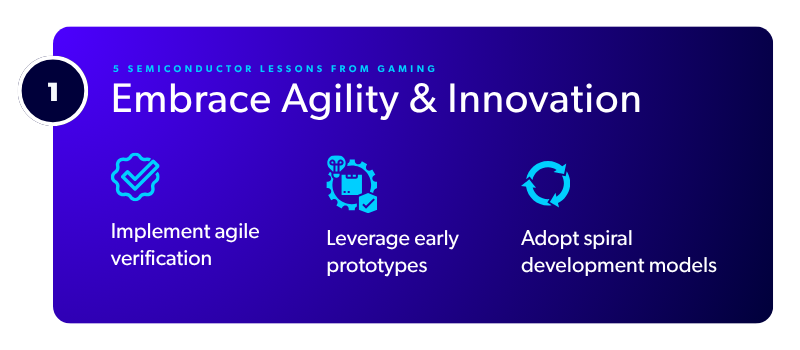
1. Embrace Iterative Innovation and Agility
The Challenge: Rigid, Waterfall-Style Development Cycles
Semiconductor firms become entrenched in rigid development cycles that feel almost ceremonial. Roadmaps are often planned years in advance, and the design process follows a rigid, waterfall-like progression from specification to tapeout. While this approach supports the careful level of control needed to prevent costly errors, it can also stifle innovation and make it difficult to pivot in response to new market demands or technical challenges.
Lesson: Develop Agility Through Iteration and Feedback.
Game development is a dynamic and often chaotic process. Studios frequently release beta versions of their games only to pivot entire projects after a single weekend of testing. This agile approach allows them to refine the user experience, fix bugs, and ensure the final product resonates with its audience.
Applying It to Semiconductors:
While the physical constraints of chip manufacturing are undeniable, the pre-production and verification stages offer significant room for agility. Semiconductor teams can adopt a more iterative mindset by:
- Implementing Agile Verification: Instead of waiting for the entire design to be complete, teams can use incremental verification techniques to test and validate smaller blocks of IP as they are developed. This allows for earlier feedback and reduces the risk of discovering major flaws late in the cycle.
- Leveraging Early Prototypes: Using Field-Programmable Gate Arrays (FPGAs) and emulation platforms allows for earlier software development and system-level testing. This creates a feedback loop that can inform hardware design long before tapeout, much like a game's beta test.
- Adopting Spiral Development Models: Rather than a linear progression, a spiral model involves creating successive iterations of a design, with each loop building upon the last and incorporating feedback and new requirements.
By divorcing themselves from long-duration design cycles, semiconductor firms can become more experimental, responsive, and ultimately more innovative.
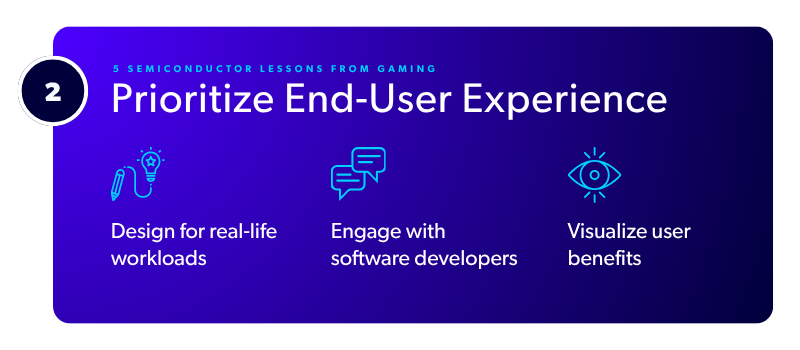
2. Understand and Prioritize the End-User Experience
The Challenge: A Disconnect from the End-User
Semiconductor companies are engineering-driven and often disconnected from the humans who ultimately use their products. They tend to focus on hitting performance benchmarks, increasing transistor density, and achieving specific power targets. While these metrics are critical, they can lead to a disconnect from the software developers and end consumers who ultimately use the technology.
Lesson: Get to Know Your End-Users.
Game developers are fanatical about the player experience. They invest countless hours in playtesting and user research to ensure that a game not only performs well but also "feels right." Gameplay mechanics, user interface design, and overall enjoyment are key to success, and developers will often scrap months of work if players don’t find the experience compelling.
Applying It to Semiconductors:
Chip designers can think beyond raw benchmarks and consider how hardware design choices impact the end application.
- Prioritize Real-World Workloads: Instead of focusing solely on synthetic benchmarks, design and optimize chips for specific, real-world applications like AI inference, high-fidelity gaming, or complex data processing. NVIDIA's success is a testament to this approach; their GPUs are designed to excel in both gaming and AI, two markets with very specific, high-performance demands.
- Engage with Software Developers: By actively engaging with the software developers who build applications on your hardware, chipmakers can gain invaluable insights into which features are most important and how to optimize chips for these programmers.
By shifting the focus from theoretical improvements to tangible user benefits, semiconductor firms can create products that offer a superior real-world experience and command greater market loyalty.
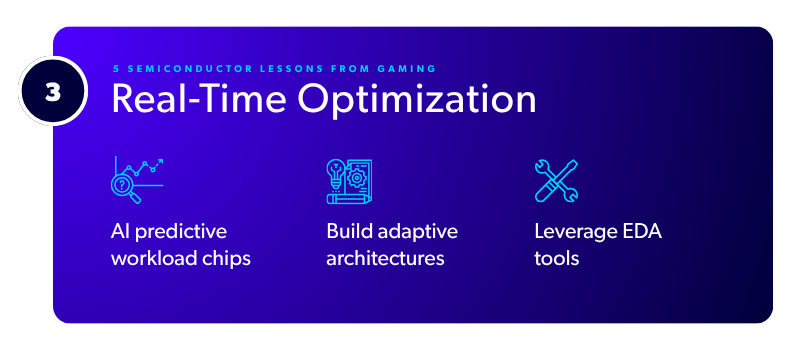
3. Implement Real-Time Optimization
The Challenge: Static, Pre-Defined Performance
A chip’s performance parameters are traditionally set during the design phase. While some level of power management exists, the hardware itself cannot adapt its core functionality in real-time in response to changing workloads. This can lead to inefficiencies where a chip may consume more power than necessary or fail to deliver peak performance when it is most needed.
Lesson: Adopt Real-Time, Game Engine-Like Adaptation
Game engines like Unity and Unreal don't simply set parameters once, they constantly adjust rendering quality, physics calculations, and asset loading to maintain a smooth and consistent frame rate. The result is a perfect balance of visual quality and performance that keeps their users engaged.
Applying It to Semiconductors:
The chips of the future should behave more like game engines by intelligently and dynamically adapting to their workloads.
- AI-Driven Design and Power Management: The semiconductor industry is exploring AI in electronic design automation (EDA) to optimize chip layouts. The next step is to integrate this intelligence directly into silicon via on-chip AI that predicts future workloads and pre-emptively adjusts clock speeds, voltage, and even processing unit configuration.
- Adaptive Architectures: Design chips with more flexible and reconfigurable components. A processor that could dynamically reallocate resources between its CPU, GPU, and neural processing units based on the specific demands of an application would always be optimized for the task at hand.
By building chips that can learn and adapt in real-time, the semiconductor industry can elevate performance and efficiency beyond what is possible in static designs.
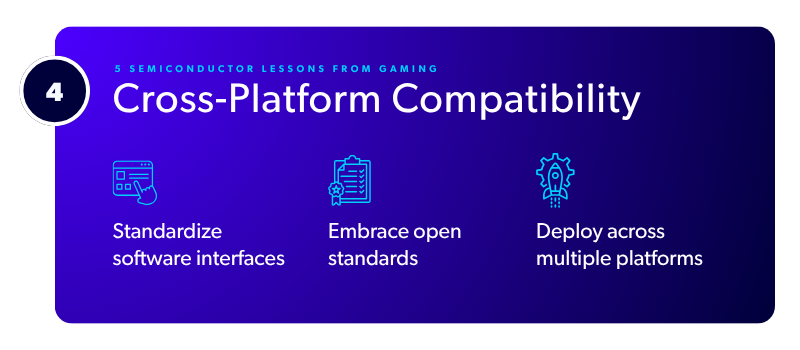
4. Break Down Ecosystem Walls
The Challenge: Fragmented Architectures and Ecosystems
Fragmented or varied architectures and proprietary ecosystems force software developers to spend significant time and resources optimizing their code for each specific platform. This lack of interoperability stifles innovation and creates a frustrating experience for developers.
The Lesson: Solve for Cross-Platform Consistency
The gaming industry has largely solved the challenge of cross-platform development. A game developed using an engine like Unity can be deployed across $3,000 PC or a five-year-old smartphone with a relatively unified feel and performance. This is achieved by focusing on tools and APIs that work seamlessly across different hardware.
Applying It to Semiconductors:
There is a significant opportunity for chipmakers to embrace this ecosystem-first mindset.
- Standardize Software Interfaces: By working together to create more standardized APIs and hardware abstraction layers (HALs), the industry can reduce the burden on software developers. The goal should be to allow developers to write code once and have it run efficiently across a wide range of hardware.
- Embrace Open Standards: Supporting open standards like RISC-V is a powerful way to break down ecosystem walls. An open and collaborative approach to instruction set architecture (ISA) design encourages broader adoption and innovation.
The days of writing completely different code for different chips should be behind us. Hardware should be designed for seamless interoperability.
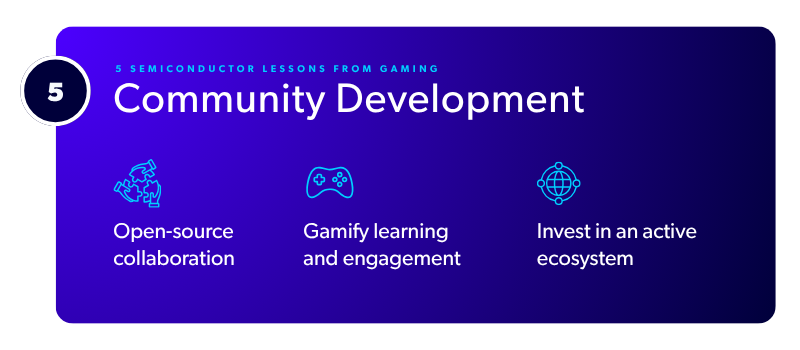
5. Build Communities, Not Just Products
The Challenge: Siloed Design Spaces and a B2B Mindset
Many semiconductor firms operate with a traditional B2B mindset, viewing their customers as other businesses rather than a community of developers and end users. This approach leads to siloed design processes and missed opportunities for valuable feedback and co-innovation.
The Lesson: Harness the Power of Community
The most successful game companies treat their communities are their greatest asset. They actively engage with players, streamers, and modders (users who create modifications for games) to obtain invaluable feedback. This symbiotic relationship elevates their products to meet consumer needs, fosters loyalty, and serves as a powerful marketing engine.
Applying It to Semiconductors:
Semiconductor firms can unlock immense value by cultivating genuine communities.
- Open-Source Collaboration: Actively participating in and contributing to open-source hardware and software projects is a powerful way to engage with the developer community. This fosters goodwill, accelerates innovation, and provides direct insight into the needs of your users.
- Gamified Learning and Engagement: The industry can draw inspiration from gaming to educate the next generation of engineers. For example, researchers at UC Davis developed "Photolithography," a game that teaches players how to build virtual semiconductors.
By transforming from closed-off component suppliers into active ecosystem participants, semiconductor companies can build stronger relationships and create products that are more aligned with the needs of their market.
Designing an Adaptive and Collaborative Semiconductor Future
AI and gaming are powerful forces propelling advancements in semiconductor technology. The companies that lead will do so by incorporating agile methodologies, real-time simulations, AI-driven automation, scalability, and user-centric design. However, this shift requires the right tools.
Perforce IPLM provides a unified environment for managing the complexities of semiconductor design, from IP lifecycle management to verification and documentation. By breaking down silos and enabling secure, global collaboration across teams, Perforce IPLM empowers semiconductor companies to adopt the agile principles of the gaming world and accelerate their path to innovation. Learn more today.

